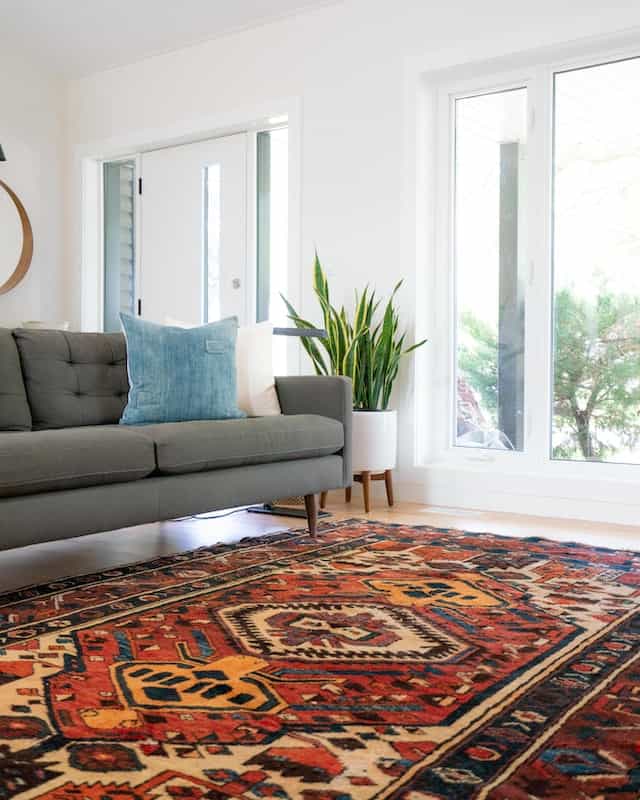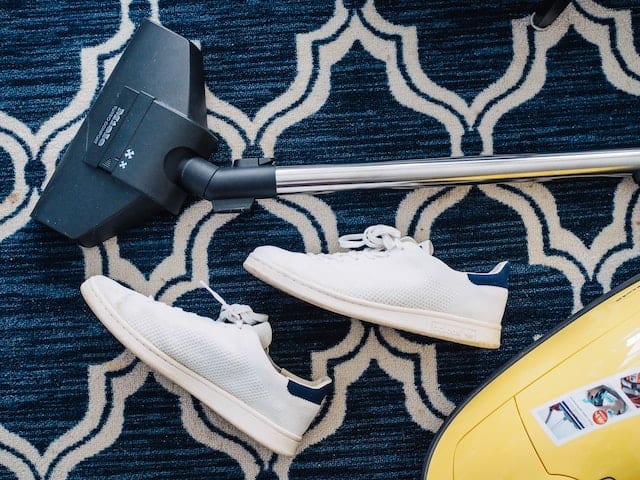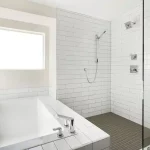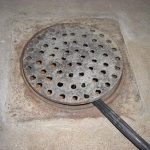Rugs are costly and made of delicate materials, so it is not recommended to put them in a washing machine.
If you want to revitalize an old rug, washing and cleaning it may help, but it won’t provide a thorough cleaning. Instead, hand cleaning is the best way to thoroughly clean your rug.
In this post, we have mentioned a detailed procedure on how to clean a rug at home, and some cleaning methods are also described below.
How to Deep Cleaning Rugs at Home?
There are several ways to clean a rug at home by hand, depending on the type of rug and the level of cleaning it needs. Here are a few steps you can follow:
- Vacuum the rug thoroughly to remove any loose dirt or debris. Use the crevice tool attachment to get into tight spaces and along the edges of the rug.
- Spot clean any stains or spills by lightly dampening a clean white cloth with a mild detergent solution and gently rubbing the affected area. Be sure to test the detergent on an inconspicuous area of the rug first to make sure it doesn’t cause any discoloration.
- For a deeper clean, you can use a mixture of mild detergent and water to gently scrub the rug by hand. Use a soft-bristled brush to work the solution into the fibers and then rinse with clean water.
- Once you have cleaned the rug, use a clean, white towel to gently press out as much water as possible and then hang the rug outside to air dry, avoiding direct sunlight.
It’s important to always check the care instructions of your specific rug before cleaning. Some rugs may require professional cleaning or special care.
10 Useful Tools for Cleaning rugs
Here are some tools that can be useful when cleaning rugs:
- Vacuum cleaner
- Soft-bristled brush
- White cloth
- Mild detergent solution
- Hose or bucket
- Carpet cleaner machine
- Clean and dry towel
- Rags or paper towels
- Scissors
- Protective gloves
Cleaning rugs requires certain tools because different types of rugs have different cleaning needs, and different tools are necessary to address those needs. For example, a vacuum cleaner with a beater brush turned off or an attachment tool that can reach the deep fibers is useful for removing dirt, debris, and pet hair from the rug. A soft-bristled brush is useful for scrubbing the rug and working in a cleaning solution. White cloths are useful for spot cleaning and blotting up spills. A mild detergent solution is useful for cleaning and removing stains from the rug without causing damage.
A hose or bucket of clean water is necessary for rinsing the rug after cleaning, and a clean and dry towel is useful for blotting up water and removing excess moisture from the rug. A carpet cleaner machine is useful for cleaning large and heavy rugs, and scissors can be used to trim any loose fibers from the rug after cleaning. Protective gloves are useful if you’re using cleaning solutions, to protect your skin.
In summary, different types of rugs require different cleaning methods and tools to ensure they are cleaned effectively and safely, without causing damage to the rug. It’s important to always check the care instructions of your specific rug before cleaning and to test any cleaning solution on an inconspicuous area of the rug before using it.
10 Types of Rugs (With Cleaning Tips)
There are many different types of rugs, each with its own unique characteristics and uses. Some common types include:
Oriental rugs
Hand-knotted rugs are made in countries like Iran, Pakistan, and India, often featuring intricate patterns and designs.
Cleaning a Oriental rug at home, you can use a mixture of mild detergent and water to gently scrub the rug by hand.
Use a soft-bristled brush to work the solution into the fibers and then rinse with clean water.
It’s important to avoid using harsh chemicals or bleach on Oriental rugs and to hang the rug outside to dry avoiding direct sunlight.
Oriental rugs are considered delicate and may require professional cleaning to preserve their quality and appearance.
Persian rugs
Persian rugs are known for their intricate designs and use of natural dyes, so it’s important to use care when cleaning them.
To clean a Persian rug at home, you can use a mixture of mild detergent and water to gently scrub the rug by hand. Use a soft-bristled brush to work the solution into the fibers and then rinse with clean water.
Avoid using harsh chemicals or bleach on Persian rugs, and hang the rug outside to dry avoiding direct sunlight.
Persian rugs are considered delicate and may require professional cleaning to preserve their quality and appearance.
Additionally, it’s important to avoid exposing Persian rugs to direct sunlight or humidity as it can cause damage to the colors and fibers.
Turkish rugs
Another type of Oriental rug, made in Turkey, is known for its bold geometric patterns and bright colors.

To clean Turkish rugs at home, you can use a mixture of mild detergent and water to gently scrub the rug by hand. Use a soft-bristled brush to work the solution into the fibers and then rinse with clean water.
Avoid using harsh chemicals or bleach on Turkish rugs, and hang the rug outside to dry avoiding direct sunlight.
Some Turkish rugs are particularly delicate and may require professional cleaning to preserve their quality and appearance.
Shag rugs
Shag rugs are made with long, shaggy fibers, often used for a cozy, casual look.
Cleaning shag rugs involves regular vacuuming, spot cleaning of stains and spills, and occasional deep cleaning. The long fibers of shag rugs can make it harder to remove dirt, debris, and stains.
Note that using a vacuum cleaner with a beater brush is turned off or use an attachment tool that can reach the deep fibers.
To clean it, you can use a mixture of mild detergent and water to gently scrub the rug by hand. Use a soft-bristled brush to work the solution into the fibers and then rinse with clean water.
It’s important to avoid using harsh chemicals or bleach on shag rugs and to hang the rug outside to dry avoiding direct sunlight.
Always check the care instructions of your specific rug before cleaning as some rugs may require special care.
Braided rugs
Braided rugs are made by braiding together strips of fabric, often used for a rustic or country-style look.
Cleaning braided rugs at home involves regular vacuuming, spot cleaning of stains and spills, and occasional deep cleaning, you can use a mixture of mild detergent and water to gently scrub the rug by hand.
Use a soft-bristled brush to work the solution into the fibers and then rinse with clean water. It’s important to avoid using harsh chemicals or bleach on braided rugs, and to hang the rug outside to dry avoiding direct sunlight.
Braided rugs are relatively easy to clean and maintain, but they are also more prone to fading, shrinking and discoloration, especially when exposed to direct sunlight or moisture.
Kilim rugs
Kilim rugs are made by weaving together flat-weave fabrics, often featuring geometric patterns and bright colors.
To clean a Kilim rug at home, you can use a mixture of mild detergent and water to gently scrub the rug by hand. Use a soft-bristled brush to work the solution into the fibers and then rinse with clean water.
It’s important to avoid using harsh chemicals or bleach on Kilim rugs and to hang the rug outside to dry avoiding direct sunlight. Always check the care instructions of your specific rug before cleaning as some rugs may require special care.
Note: because Kilim rugs are flat-woven, they don’t have piles and therefore they don’t require regular grooming.
Natural fiber rugs
Natural fiber rugs made from natural materials such as jute, sisal, and seagrass, are known for their durability and earthy look.
Cleaning a natural fiber rug at home, you can use a mixture of mild detergent and water to gently scrub the rug by hand. Use a soft-bristled brush to work the solution into the fibers and then rinse with clean water.
It’s important to avoid using harsh chemicals or bleach on natural fiber rugs and to hang the rug outside to dry avoiding direct sunlight.
Natural fiber rugs are relatively easy to clean and maintain but they are also more prone to fading, shrinking, and discoloration, especially when exposed to direct sunlight or moisture.
Hand-tufted rugs
Hand-tufted rugs are made by pushing yarns through a fabric backing and then trimming the fibers to create a plush pile.
To clean a hand-tufted rug at home, you can use a mixture of mild detergent and water to gently scrub the rug by hand. Use a soft-bristled brush to work the solution into the fibers and then rinse with clean water.
It’s important to avoid using harsh chemicals or bleach on hand-tufted rugs and to hang the rug outside to dry avoiding direct sunlight.
Additionally, hand-tufted rugs should be professionally cleaned more frequently than other types of rugs as the yarns can be easily pulled out during regular cleaning.
Machine-made rugs
Machine-made rugs created by machines, are often made in large quantities and are less expensive than handmade rugs. They can be made from a variety of materials, such as synthetic fibers, wool, or a combination of both.
These rugs often have a more consistent look and feel than handmade rugs and are easier to maintain.
They are a good option for those looking for a budget-friendly rug that can withstand heavy traffic and regular use.
Cleaning a machine-made rug at home is generally similar to cleaning flatweave rugs. Vacuuming regularly is the best way to remove dirt and debris. Spot clean any stains or spills immediately using a mild detergent solution.
Machine-made rugs can be cleaned by using a mixture of mild detergent and water, a brush and a hose, or by using a carpet cleaner machine.
It’s important to avoid using harsh chemicals or bleach on machine-made rugs and to hang the rug outside to dry avoiding direct sunlight.
Flatweave rugs
Flatweave rugs are made by weaving together fabric yarns to create a flat surface, often used in high-traffic areas, and are easy to clean.
Cleaning a flatweave rug at home involves regular vacuuming, spot cleaning of stains and spills, and occasional deep cleaning with a mild detergent solution.
It’s important to avoid using harsh chemicals or bleach and to hang the rug outside to dry avoiding direct sunlight. Rotating the rug every six months can prevent uneven fading and wear.




